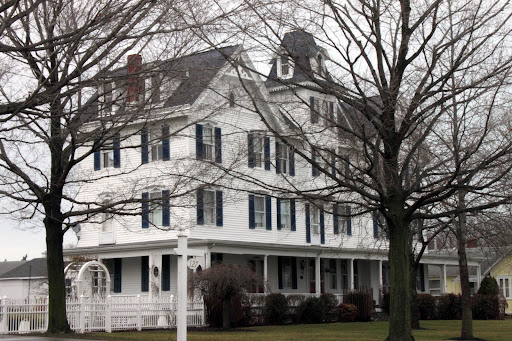
Welcome to a Kelleys Island Historic Home Tour!
The Tour has 18 stops of interest.
Each stop will have a photograph and a brief description.
Kelleys Mansion
211 East Lakeshore Drive
Begun in 1862 and completed in 1867, this fine house, constructed of locally quarried limestone, was then and still is one of the most impressive structures of the Lake Erie Islands.
Designed by J. B. Merrick of Sandusky for Addison Kelley, son of Datus, the interior features include carved woods of various kinds (cherry, butternut, chestnut, and black walnut), magnificent stained and etched glass, and a self-supporting oak spiral staircase, which is the centerpiece of the house.
The mansion remained in the Kelley family until 1928 when it was sold to the short-lived Cleveland Sportsman's Club. In 1933, it was acquired by the Dominican Sisters of Adrian, Michigan, serving as a retirement home for nuns, and, later, as a summer camp for girls. It was during this period that a number of adjacent buildings were constructed.
The Kelleys Mansion is currently privately owned and is not open for tours.
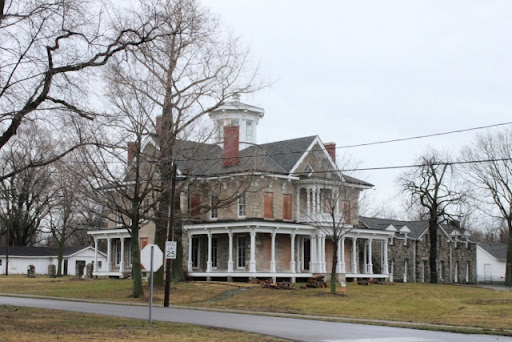
Inscription Rock

This large limestone rock is on the south shore of Kelleys Island,near the Kelleys Mansion.. The remains of at least two Native American villages were found very near the rock. Archaeological and historical research suggests that until about 1643 AD, Algonquian-speaking groups affiliated with the "Fire Nation" confederacy populated the Sandusky region. Historical references describe a water route of travel via Lake Ontario to the western basin of Lake Erie, an area rich in beaver pelts. It is assumed it was these pre-historic groups or members of roving bands of Iroquoian peoples (Neutral, Erie, Cat) after 1643 that carved the rock’s markings.
The 32 x 21’ surface of the rock is covered with one of the finest examples of aboriginal art in the Great Lakes region. Known as a petroglyph, no one is sure what the unusual drawings depicted. The most widely accepted theory is that the large rock was used as a "message stone" where various Native Americans would make drawings,noting that they’d been there, how the hunting or fishing had been and/or where they were headed next. The markings have been so eroded by exposure to the weather that it is difficult to see them. In 1969 The Ohio Historical Society erected a cover to attempt to preserve the rock. A small-portion plaster replica of the accurate and detailed sketches done in the 1850’s is at the site.
Koster's Dock-Unique Marker Club

Corner of Addisson and East Lakeshore Drive
Originally built in 1883 as a wine dock by Merman Koster, it was enlarged in 1889 to facilitate shipment of his products. Later, when the Koster Winery went out of business, the dock was used by the Sweet Valley, Monarch, and Meiers Wine Companies. From 1907 to 1945 it was owned by the Kelleys Island Lime and Transport Compan. From 1921 to 1955 it was used by the Lay Brothers Fish Company. In the latter year, the dock was taken over by the Kelleys Island Fish Producers Co-op as a parking and transfer station. Since commercial fishing ceased to be profitable in the 1960's, it has been used for other purposes: marina, chartered sports fishing boats, etc. and is now owned by the Unique Marker Club.
The Pape House
133 East Lake Shore Drive
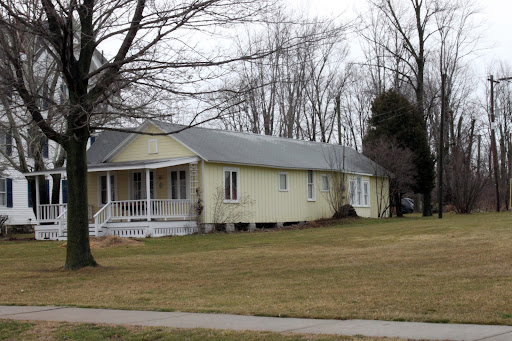
Built in 1886 as a two-lane bowling alley, with a two-story saloon in front, this was an auxiliary building to the Himmelein House. In addition to the bowling alleys, there also was a billiards room.
After the Himmelein house ceased operation as a hotel, the two-story saloon in front of the present building was razed and an entrance porch was added to the remaining structure. The building then was converted into a summer cottage by Richard Himmelein (son of, John) and his friend, Fritz W. Pape. In 1943, a further alteration was made when a 30-foot section to the rear of the building was demolished.
The building is still used by the descendants of Fritz Pape as a summer residence. It is not open to the public.
The Himmelein House
131 East Lake Shore Drive

Over the years, Kelleys Island has had many fine hostelries, but none more famous than the Himmelein House. The first section was built about 1859 by Johann (John) Himmelein as a private residence. However, by 1870, census records show that it was being used as a hotel.
By 1890, after enlarging the original structure by the addition of two wings and a third-story, the Himmelein House reached the size it is today. For nearly three decades following the renovation and enlargement, it served as a center for rest and entertainment of summer guests, including Grover Cleveland and William Howard Taft. In addition, Mr. Himmelein and, later, his son-in-law, Gus Sun, were both nationally known theatrical booking agents who not only entertained many of their clients here, but, also, sponsored professional performances on the Island.
The house was sold to a new owner and is now a private residence.
The Beatty House
119 East Lake Shore Drive
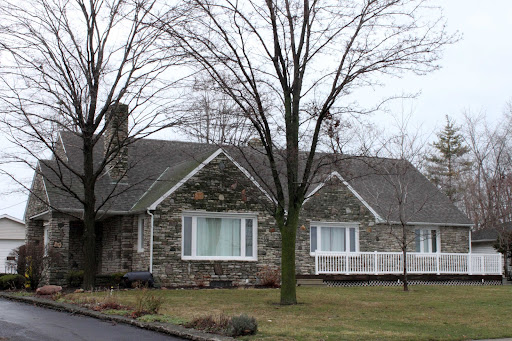
In 1948, Gottfried Schock, a master stonemason, built this impressive house for Henry and Rosella Beatty.
Henry Beatty, a descendant of German immigrant, Louis Beatty (originally Ludwig Bette), was a prominent citizen and businessman on the Island, one of the last of the successful commercial fishermen of the Western Basin of Lake Erie. In addition, Mr. Beatty served on the Village Council and as Mayor (1948-1958), as the first ranger-administrator of the Kelleys Island State Park and on the Board of Public Affairs, which operates the Island's water system.
The house itself is constructed of hand-cut, locally quarried limestone and, like most of Gottfried Schock's work, is a monument to his craftsmanship. It was the last major project undertaken by Mr. Schock prior to his retirement.
The Henry Beatty House is a private residence and is not open to the public.
The Cricket Lodge
111 East Lake Shore Drive

Known as "Cricket Lodge," this house was built by John Himmelein & his wife, vaudeville actress Beatrice Earle, in 1906. Dorothy Himmelein Sun, daughter of John Himmelein, had married Gus Sun, Jr., nationally known theatrical promoter and booking agent. Over the years, guests to the home often were world famous musicians, actors, and actresses of the legitimate theatre. Later additions to the house greatly added to its beauty and potential for entertaining.
In 1985, Dorothy Sun sold "Cricket Lodge" to Chris and Frank Yako, who now operate it as a bed and breakfast. It is located near Downtown and has a private dock for guests to enjoy scenic views of the lake.
The Timothy House
East Lake Shore Drive
This house, a modified French Romanesque style, was built in 1683 by Henry Kelley, grandson of Irad Kelley. He had begun his career as a clerk at "The Lodge,"now known as “Captain's Corner”. but, in 1900, became Assistant Superintendent of the Kelleys Island Lime and Transport Company.
Since 1910, the house has had a series of owners and residents, its next to last being Irma Dodge Conkle, who, for many years, was the manager of the Kelleys Island Dock and Steamboat Company. Most recently, called "Timothy House," it is privately owned and maintained.
The Kelleys Cottage
127 West Lake Shore Drive

This "Steamboat Gothic" cottage was built in 1861 by William Dean Kelley, youngest son of Datus Kelley. It is one of several houses constructed by members of the Kelley family located along the Island's south shore.
A rather common Gothic design of its time, with a two-storey center section flanked by single storey wings, it has remained in the Kelley family since it was erected, for the most part used as a summer residence.
Its builder, William Kelley, had served as a teacher in the Island school and was a veteran of the Civil War. His son, William Datus Kelley, was a civil engineer who surveyed a route for the Intercontinental Railroad through Ecuador and Peru. His grandson, William, was associated with the Nickel Plate Railroad. The present owner maintains it as a private summer residence.
This "Steamboat Gothic" cottage was built in 1861 by William Dean Kelley, youngest son of Datus Kelley. It is one of several houses constructed by members of the Kelley family located along the Island's south shore.
A rather common Gothic design of its time, with a two-storey center section flanked by single storey wings, it has remained in the Kelley family since it was erected, for the most part used as a summer residence.
Its builder, William Kelley, had served as a teacher in the Island school and was a veteran of the Civil War. His son, William Datus Kelley, was a civil engineer who surveyed a route for the Intercontinental Railroad through Ecuador and Peru. His grandson, William, was associated with the Nickel Plate Railroad. The present owner maintains it as a private summer residence.
Datus Kelley House
115 Division Street
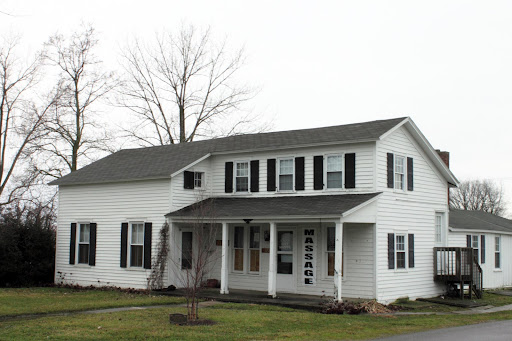
This is the oldest house on Kelleys Island. Built in 1835 by Addison Kelley for his father, Datus, the original portion is of squared log construction. About 1850, frame additions were made and, today, it resembles a flew England saltbox style.
Over the years, the house has been adapted to the living styles of its various owners. Today it is used for various business activities.
Kelleys Island Town Hall
119 Division Street

In the fall of 1861 , Datus Kelley and his wife, Sarah, conveyed to the village as a gift this fine stone structure. Dedicated to "Truth," it was to be used as a site for all sorts of meetings and public entertainments. And, indeed, it is now the community center for the Village.
It is used for annual events,sports activiities,Council Meetings and is available for various Island
Forums or Presentations.
The Island Police Department and EMT are also on the same location of the Town Hall.
The Island House
117 Division Street

Built in 1876 by Henry Trischman, a German immigrant from Hesse, this large, Italianate-styled house stands as a tribute to its builder's success in his adopted country.
Trischman, with his wife and brother, had come to the United States sometime in the 1860's. After a short residence in Sandusky, they came to the Island and started a butcher business in what is now the Island Market. Trischman not only operated his own slaughterhouse, but fattened his own livestock on a 35-acre plot on Monaghan Road. In addition, he also owned a vineyard and was one of the founders of the Sweet Valley Wine Company. As a public-spirited citizen, he served both as a township trustee and as a member of the school board.
In recent years, the house has been converted and enlarged to serve as a restaurant, The Island House, without spoiling its basic architectural integrity.
The South Side School
119 Division Street

The South Side School was built in 1853 to replace a frame building, which had stood on a site nearby, which had been constructed in 1837. The first floor housed the elementary students; the second story had classrooms for the 7th and 8th grades.
The South Side School was closed in 1901, when the Estes School opened and all Island classes were consolidated there. The building was sold and became a private residence, which it remains to this day. For a time, c. 1950-1935, an addition to the west side of the stone structure was used as the Kelleys Island Public Library.
Schock House
142 Division Street
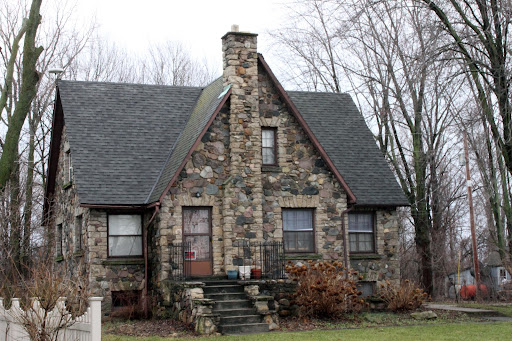
Gottfried Schock (later spelled both Godfrey and Godfried) was trained as a stone mason in Germany before his immigration to Kelleys Island in 1918. Though at first he worked in his cousins' vineyards, within a short time he employed his masonry skills both on the Island and the mainland. On Kelleys, he built the kitchen and dormitory buildings at the Kelley Mansion, the War Memorial in the Village Park, and five fine Island houses, including his own on Division Street. In addition in his forty-five year active career he built two churches (one in Marblehead and one in Detroit) and constructed countless decorative and functional stone structures, ranging from fireplaces, steps, walls, etc. His artistic skills are nowhere more apparent than demonstrated in his own home.
Zion Methodist Church
101 Chappel Street
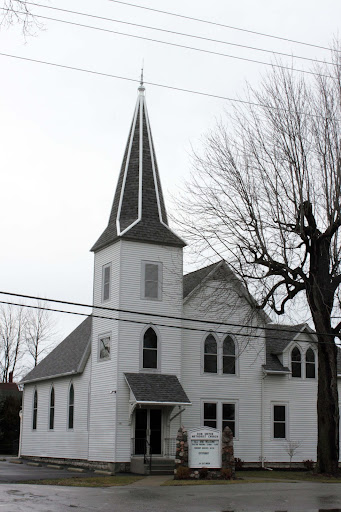
This building was constructed in 1893. Its membership was composed of a number of Protestants on the Island and, at the time the present building was erected, the congregation was associated with the Evangelical United Brethren sect. Soon after, though, it became a part of the Congregational Church of Ohio. For many years, it was known locally as the Community Church, but in recent times has been a charge of the United Methodist Church. Though its membership, because of the Island's year round population loss, has dwindled , during the summer months Sunday attendance fills the pews to overflowing. At the present time, it is the only Protestant church in operation on the Island. Renovations and improvements over the years have seen the building enlarged and modernized. It is served by a part-time lay pastor.
Old Stone Church and Kelleys Island Historical Association
222 Division Street Street

In 1865, German‑speaking Protestants on the Island organized the German Reformed Church. Two years later, they dedicated this church building which had been built with their own labor from stone quarried on their own property. Regular services were held in the church until the early 1900's, by which time most of the members were gone. The building, complete with pews, altar furnishings, and other accoutrements was unused, except for meeting of a Ladies' Aid Society.
In September, 1980, the Kelleys Island Historical Association was formed and, the following year, a lease-purchase arrangement was made with the Northwest Ohio Association of the United Church of Christ, which held the deed to the property. In 1986, the Historical Association gained outright ownership and, after much restoring and refurbishing, currently uses it as part of the headquarters and museum complex.
This complex organizes,maintains and displays artifacts, photographs and documents of Kelleys Island. It is an all volunteer association and is a fantastic source of Island information for both residents and Visitors.
St. Michael's Catholic Church
219 Chappel Street

Organized in 1861, the congregation which was to become St. Michael's met in private homes and was served by visiting priests. Two years later, the "little stone church" was constructed by the forty-four families of the newly formed parish. However, by 1915, the membership had doubled and St. Michael's was considerably enlarged. In recent years, the interior has been remodeled along simpler lines. The altar and communion rail came from an old mission church in Sandusky. From 1876 to 1936, the St. Michael's congregation operated a parochial school in a separate building across the street. In recent years, it has been served by visiting priests though, for much of its history, resident pastors ministered to the congregation.
Organized in 1861, the congregation which was to become St. Michael's met in private homes and was served by visiting priests. Two years later, the "little stone church" was constructed by the forty-four families of the newly formed parish. However, by 1915, the membership had doubled and St. Michael's was considerably enlarged. In recent years, the interior has been remodeled along simpler lines. The altar and communion rail came from an old mission church in Sandusky. From 1876 to 1936, the St. Michael's congregation operated a parochial school in a separate building across the street. In recent years, it has been served by visiting priests though, for much of its history, resident pastors ministered to the congregation.
Sennish House
126 Addison Street
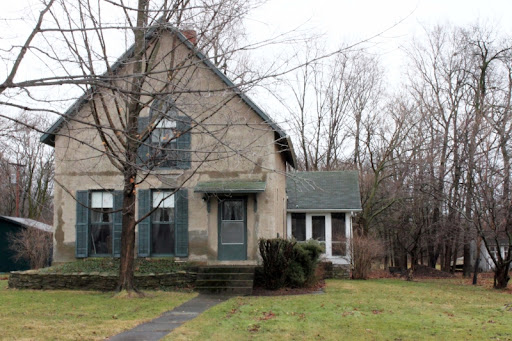
The Sennish house was built by Addison Kelley, for his oldest son,Frederick during the Civil War.
Frederick Kelley died in 1864 and his widow, Angeline Woodford Kelley, became the owner of the house.The house changed ownership over many years and eventually was owned and maintained by Jim and Anne Sennish.
The Sennish house concludes the Tour of 18 interesting sites centered around the downtown area of Kelleys Island. This tour is a small sample of the dozens of historic homes on Kelleys Island.
Thank you for visiting Kelleys Island and please return again in the near future!

Thank you for taking a Tour! PLease visit the Kelleys Island Chamber of Commerce WebSite for more information.
419-746-2360
